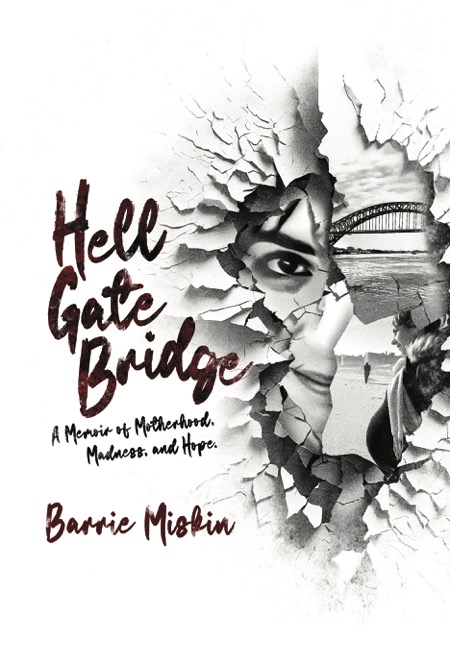Reviewed by Diane Gottlieb
 When you suffer from mental illness, the world does not treat you kindly. People with mental health challenges are subject to harsh judgments and often feel dismissed or shamed.
When you suffer from mental illness, the world does not treat you kindly. People with mental health challenges are subject to harsh judgments and often feel dismissed or shamed.
When a woman suffers from mental illness and is pregnant or has recently given birth, her road becomes much more difficult. She receives little compassion or support and is instead seen as irresponsible, selfish, neglectful. Add to that the mishaps and mistreatment at the hands of mental health professionals and her everyday becomes a seemingly unbearable struggle. Because of the daunting stigma attached to such experiences, many women suffer in silence.
Barrie Miskin courageously breaks this silence in Hell Gate Bridge: A Memoir of Motherhood, Madness, and Hope (Woodhall Press; June 2024).
Miskin grips us right from the start. The prologue revisits December 4, 2017, the day she “became lost.” It was four months before she gave birth to her daughter, weeks that she hadn’t been sleeping, and one week since she’d last gone to work. Miskin was in trouble.
She’d been on a low dose of Zoloft since her early twenties but took herself off the medication when, at 38, she and her husband Patrick decided they wanted to have a baby. While Miskin was no stranger to depression, she began to experience new, strange feelings and obsessions and describes her days as “stretching before me like the hall in a house of mirrors.” Paralyzed by fear, Miskin found the strength that December day to act on a suggestion from her well-meaning but ill-informed psychiatrist—she took a walk. When she got to Hell Gate Bridge, she fell apart:
Testing myself, I walked quickly down the jogging path … At the bottom of the hill, the path ended and I reached the river … Hell Gate Bridge loomed above … I had the sensation then of being zipped up inside a plastic bag … Hands shaking, I peeled off a woolen glove and fumbled for the phone in my purse. ‘Babe,’ my voice was high and choked. ‘I need you to come get me. I’m in Astoria Park. I can’t remember how to get home.’
Hell Gate Bridge is an apt metaphor. Miskin’s symptoms were many, severe, and disorienting. She developed body dysmorphia: “I was convinced that hairs and spots were appearing on my face and body, and I began checking for these illusory changes, waking up at 3:00 a.m. to sneak into our tiny bathroom and examine my face in the mirror.”
A bit later, Miskin became even more disconnected from reality: “Everyone—from my family to people I had just met—had become body doubles of themselves, alien proxies. … I knew they were still real … but I had to live with this new demented thought distortion.” It was if Miskin was trapped on a hellish bridge, unable to cross, with her husband, her daughter, her health reaching out to her from the other side.
Miskin’s memoir is not only a harrowing depiction of an individual’s painful journey but a stinging indictment of the mental health profession. As a former clinical social worker, I was horrified by the lack of appropriate medical and psychiatric care Miskin received. As a human being, a woman, and mother, I was appalled by the insensitivity of those charged with that care.
Miskin writes in detail about the two instances she was hospitalized in inpatient psychiatric units. Even while in the psych ER, she felt as if she was being punished:
“I had the same sensation—sinking dread—that used to come over me when I had brought home a bad grade in chemistry or got caught smoking in the parking lot freshman year of high school. I was about to get in trouble. But what had I done wrong? I was unwell, I was pregnant, I was terrified …”
Once admitted, Miskin discovered parallels with prison: “I am assuming the conversation among inmates is akin to the conversation among patients in psychiatric hospitals. It revolves around two questions: ‘What are you in for?’ And ‘When are you getting out.’” The similarities do not stop there, as “good behavior” often the key to a shorter stint. Miskin made several mistakes: she didn’t sleep enough, she paced too much, she asked too many questions, and she cried—a lot:
When the doctors commented on my excessive crying, citing my ‘poor coping skills,’ I would apologize. ‘I’m sorry,’ I would say, ‘but I have a five-week-old baby at home. I’m sick and I’m trying everything, but nothing is making me better and no one is helping me. Wouldn’t you be crying too?’ I always wondered about the doctors’ accusations of my visible sadness. Should I have been stoic? Happy? Wasn’t it more appropriate to be sad?”
Doctors made snap diagnoses on little information or observation—diagnoses whose treatment called for heavy-duty prescriptions with serious side effects. When treatments didn’t work, many of the doctors doubled down, increasing the dosages. When that too proved ineffective, they shoved Miskin to the side. What the professionals didn’t do was question themselves. Could they have misdiagnosed her? Could they be … wrong?
It turns out they were. Miskin was suffering from depersonalization/derealization disorder or DPDR, a rare psychiatric illness, whose treatment is exposure therapy “a therapy that involves the patient putting themselves in situations they would deem terrifying until the terror slowly diminishes and the situation just becomes a part of normal life again.” It is an incredibly slow, grueling recovery process, but thankfully, she finally found herself in good hands—Dr. Sariss, an expert in the treatment of DPDR, whose belief that Miskin could get better and her insistence on Miskin doing the hard work made all the difference in the world.
Miskin’s journey was long and tedious. It was fraught with enormous pain that, at times, seemed like it would never end. Patrick was there at every turn—a truly remarkable testament to the love between them, and Nora, their daughter, brings them both tremendous joy.
One of Miskin’s and Nora’s favorite activities is swimming in the public pool at Astoria Park. Miskin describes what happened on one particular day: “In the distance, to the left, was the Queensboro Bridge. To the right was the Hell Gate. I barely noticed it. … It was just a bridge.”
When Miskin looked up the history of the bridge, she learned the name had “nothing to do with the Gates of Hell after all. It’s from the word Hellat, a Dutch word meaning ‘clear passage.’” Miskin surely walked through the Gates of Hell to arrive at her own clear passage, but as the full title of the book says, her story is one of Motherhood, Madness, and Hope. Hope may be the most powerful takeaway from this important, courageous memoir.

Diane Gottlieb is the editor of Awakenings: Stories of Body & Consciousness (ELJ Editions) and the Prose/CNF editor of Emerge Literary Journal. Her writing appears or is forthcoming in Brevity, Witness, Colorado Review, River Teeth, Florida Review, Chicago Review of Books, HuffPost, Hippocampus Magazine, 2023 Best Microfiction, and The Rumpus, among many other lovely places. She is the winner of Tiferet Journal’s 2021 Writing Contest in nonfiction, longlisted at Wigleaf Top 50 in 2023 and 2024, finalist for The Florida Review’s 2023 Editor’s Prize for Creative Nonfiction and finalist for the 2024 Porch Prize in nonfiction. Find her at dianegottlieb.com and @DianeGotAuthor.
The post REVIEW: Hell Gate Bridge: A Memoir of Motherhood, Madness, and Hope by Barrie Miskin first appeared on Hippocampus Magazine.
Go to Source
Author: Donna Talarico